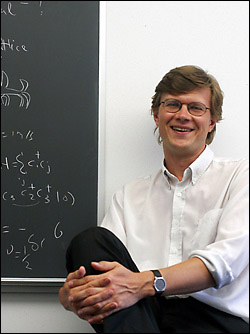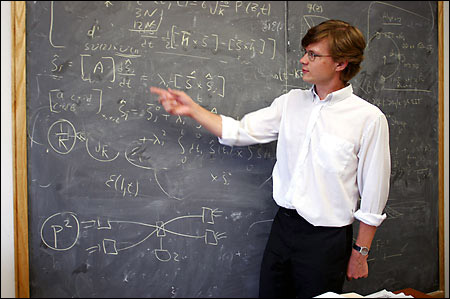Lukin illuminates quantum science
Understanding the ‘supers’ and ‘ultras’ of matter

Mikhail Lukin thinks that devices based on quantum science are at the same stage as radios were about 100 years ago. To catch up, the recently tenured professor of physics is stopping and storing light, making artificial atoms behave in new ways, and doing engineering with superconductivity. When quantum does overtake kilowatts, you can expect novel products like quantum transmitters and quantum computers that will change the world the way that radios and electronic computers have.
For the past five years, Lukin and his Harvard colleagues have stunned the world by stopping pulses of light, storing them, and manipulating them. These are the first steps toward making quantum computers whose information is contained in the physical or quantum state of light pulses rather than electrical pulses. He sees such quantum computing and communication as being at about the same stage as experiments in electricity when Guglielmo Marconi broadcast the first dots and dashes of Morse code through the air.
“We are still at the level of basic research, but practical applications may not be too far in the future,” says the 33-year-old Moscow native. “By manipulating single photons of light, we should be able to transmit information via codes that cannot be cracked by terrorists, commercial spies, or hackers – “q-mail instead of e-mail.”

Experimental quantum networks already send such messages, but only over distances of a few miles. One such network operates between Harvard and Boston University, a distance of a few miles. Lukin, however, envisions much more sophisticated systems that will transmit signals around the world.
Marconi’s first broadcast, in 1895, went about a mile. By 1901 radio messages spanned the Atlantic. Almost 100 years passed before the Internet spanned the globe.
Lukin’s quantum future also includes computers that may help explain high-temperature superconductivity, the capability of some materials to carry electricity without any resistance at temperatures relativity easy to attain. These temperatures reach hundreds of degrees below freezing but can be handled with available technology.
“For more than 10 years, researchers have been developing high-temperature superconductive wires and devices,” Lukin points out. “But how this phenomena actually happens is still not well understood.” Comprehending such “supers” requires theoretical analyses too complicated for the best computers now in operation, which Lukin refers to as “classical” computers, as though he were speaking about old pianos.
“We are just at the beginning of using quantum systems that we can understand and manipulate to model or simulate systems that we cannot,” Lukin says. His style of following up ideas with experiments, then using the results to generate newer ideas and experiments is rare in the physics business, where theoreticians and experimenters usually walk separate paths.
“Misha proposes beautiful ideas and connects them to realistic experiments,” notes colleague Eugene Demler, a Harvard physicist who has worked with Lukin. “He works on the most challenging problems in several different areas of physics. And his track record is astounding. I know of at least two occasions when his experiments have been in the list of the world’s 10 most important physics experiments of the year.”
In addition,” notes Professor of Physics John Doyle, “he has a sunny personality peppered by a dry Russian wit. He’s a great guy to enjoy a meal with.”
From films to physics
Although his mother, father, and brother trained as physicists or mathematicians, Lukin never intended to follow their lead. He was more interested in making documentary films, and spent many hours working on them in a Moscow studio while in high school.
“I was fascinated by it,” he recalls.
But during his last year of high school, Lukin’s parents persuaded him to attend a series of special lessons in physics. “Our teacher was extraordinarily talented,” he says. “After the first class, I was so captivated I decided to keep studying physics.”
Lukin did this at the Moscow Institute of Physics and Technology, where he earned a master’s degree in applied physics and mathematics in 1993. During a conference in Russia, he met another person that changed the direction of his life. A physics professor from Texas A&M University asked him if he would be interested in coming to Texas to work on his Ph.D.
“I didn’t know Texas from Massachusetts at the time, but the Iron Curtain was opening, so I said, ‘yes,’” Lukin remembers. After completing his Ph.D. in 1998, he won a postdoctoral fellowship at the Institute for Theoretical Atomic and Molecular Physics at the Harvard-Smithsonian Center for Astrophysics. Since then, he has learned lots of new physics as well as the difference between Texas and Massachusetts.
By 2001, Lukin was an assistant professor in the physics department at Harvard, and by 2004, he had earned tenure. That’s less time than it took him to receive a Ph.D. On the way, he won the National Science Foundation Career Award, a David and Lucile Packard Fellowship for Science and Engineering, and an Alfred P. Sloan Fellowship.
Cold atoms and hot ideas
Lukin and his colleagues are now working on schemes that seem straight out of science fiction. For example, they want to build synthetic crystals in which artificial atoms are held together by the energy of light waves. By manipulating the light, interactions between the atoms might be precisely directed. “We could control how each of the atoms “talk” to each other,” is how Lukin puts it. It’s another way of trying to understand and control things that we can’t understand and control now.
To advance the pace of such work “requires a boiling pot of research and education whose ingredients should include experts in everything from fundamental science to practical engineering.” Lukin says Harvard is such a place. He cites examples of ingredients like the coolly named Center for Ultracold Atoms, where temperatures hundreds of degrees below zero slow down fast-moving atoms so their behavior can be measured. There is also the Institute for Theoretical Atomic, Molecular and Optical Physics, where Lukin was a postdoctoral fellow, and the new Institute for Quantum Science and Engineering, where researchers from many different fields focus on bridging the gap between theory, basic research, and practical engineering.
Marconi didn’t have anything like that going for him.




